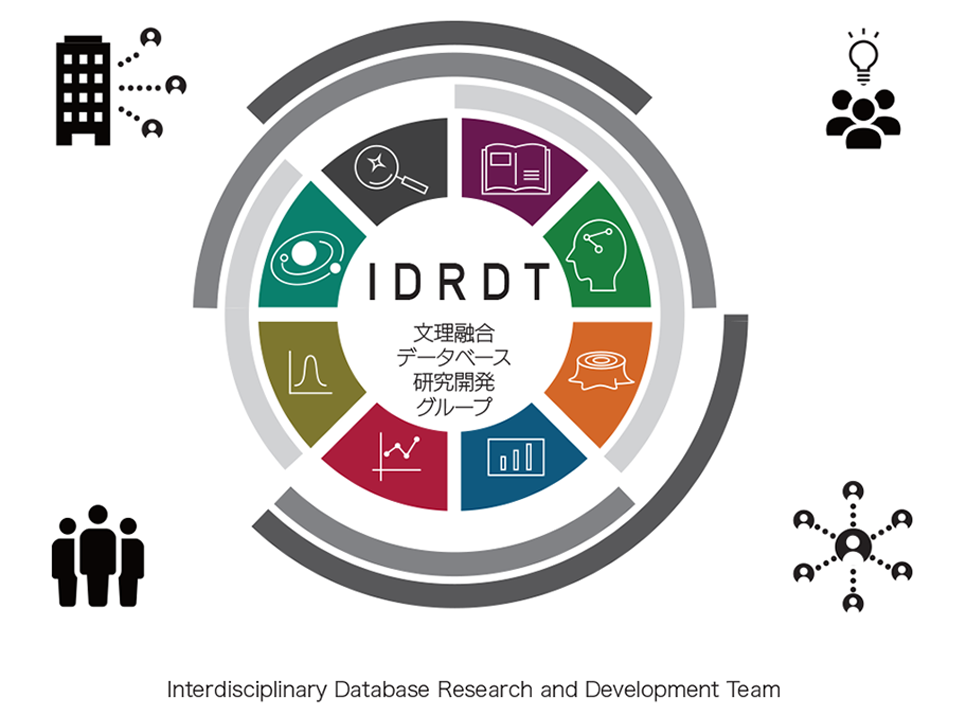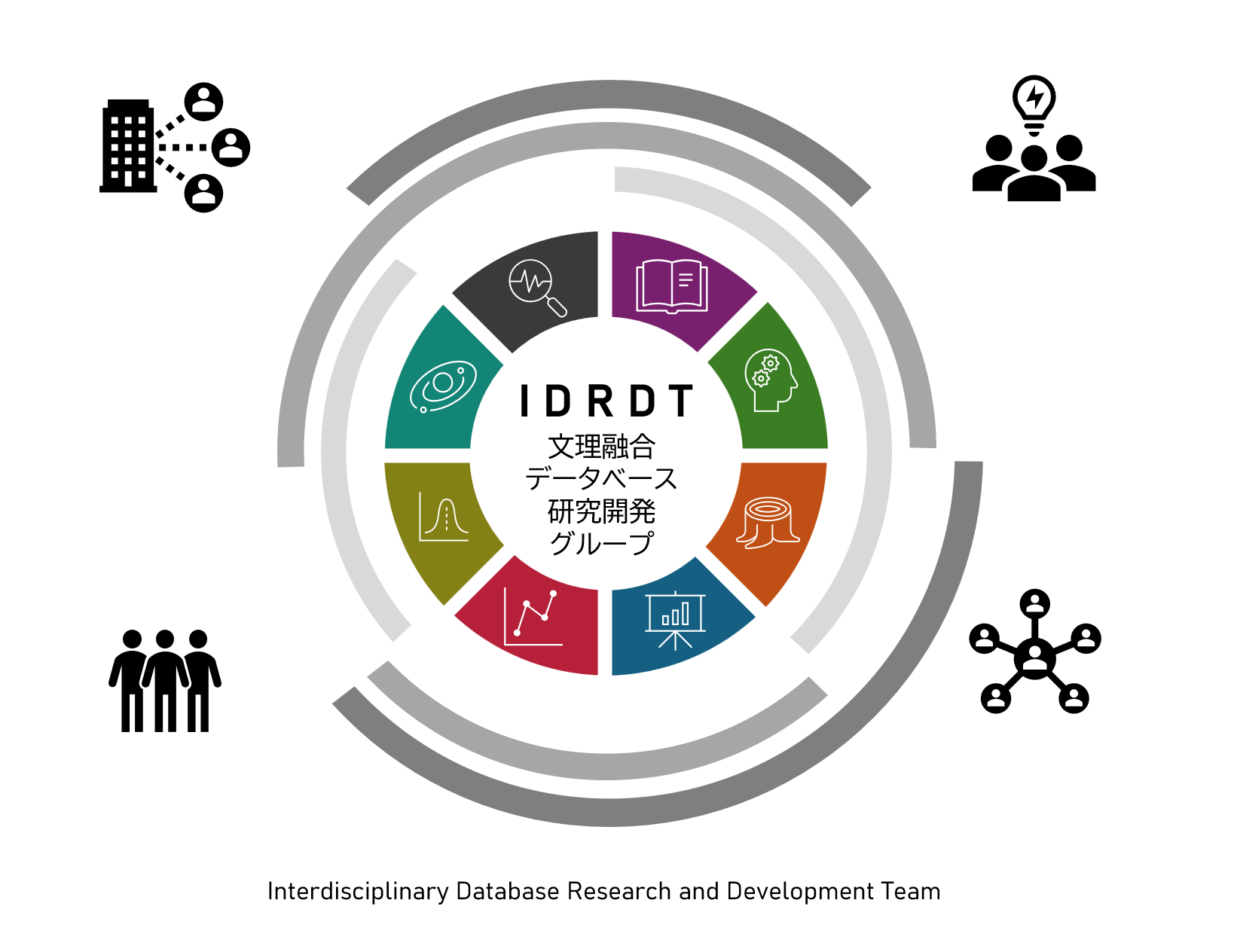Interdisciplinary Database Research and Development Team
Metadata registration and publication to promote research that integrates the humanities and sciences
In collaboration with the Joint-Support Center for Data Science Research (ROIS-DS) and the Institute of Statistical Mathematics, Research Organization of Information and Systems, Institute for Space-Earth Environmental Research (ISEE), Nagoya University is working to promote integrated research of humanities and sciences on space-terrestrial environments by creating and registering metadata for various field of data sources generated by other research teams such as historical documents, cultural heritage data, and extreme space weather data, and by assigning DOIs to publicly accessible data to facilitate citation and further dissemination. With a focus on use cases for integrated research, this group aims for research and development from the viewpoint of how metadata and database structures are effective for enhancing scientific outcomes and improving humanities insights.

Members
Institute for Space-Earth Environmental Research, Nagoya University
Yoshizumi Miyoshi
Professor
Center for Integrated Data Science / Division for Integrated Studies / Office for the Promotion of Transdisciplinary Network (OPTN)
Heliospheric System Science, Space Weather
My major research topics are solar-terrestrial/planetary physics, including studies of auroras, radiation belt variation in the context of the heliosphere system science, using various data from satellites, ground-based observations, and simulations. Additionally, I am engaged in foundational research for space weather forecasting using simulations and AI.
Bio page, Division for Integrated Studies, Institute for Space-Earth Environmental Research, Nagoya UNIVERSITY.Yuichi Otsuka
Associate Professor
Division for Ionospheric and Magnetospheric Research / Center for Integrated Data Science / Office for the Promotion of Transdisciplinary Network (OPTN)
Ionosphere, Upper atmosphere, GPS
Using GPS, which is widely used for car navigation, smartphones, etc., the ionosphere, located at the top of the Earth's atmosphere, can be studied. Although the ionosphere causes errors in GPS positioning, these errors are very useful for ionospheric studies. We collect GPS data from around the world to study the plasma density in the ionosphere. Additionally, we install GPS receivers in Indonesia and Thailand to investigate ionospheric disturbances occurring in the equatorial ionosphere.
Yuichi Otsuka's web siteAyatoshi Taniguchi
Research Assistant
Joint Support-Center for Data Science Research, Research Organization of Information and Systems
Akira Kadokura
Project Professor
Polar Environment Data Science Center
Magnetospheric Physics
I have been studying the interhemispheric conjugacy of auroral phenomena by analyzing the data obtained in the simultaneous conjugate observation between Syowa Station, Antarctica and Iceland, together with the observation network in the Antarctic continent. I have been also promoting the database creation and data distribution for the auroral related data obtained in a long term observation in both polar regions.

Data Center for Aurora in NIPR
Yoshimasa Tanaka
Associate Professor
Polar Environment Data Science Center, National Institute of Polar Research, Research Organization of Information and Systems/Polar Science Program, The Graduate Institute for Advanced Studies, SOKENDAI
Upper Atmospheric Science, Database
I am studying the upper atmosphere, especially the ionosphere and magnetosphere, through data analysis of geomagnetic phenomena (e.g., aurora and magnetic pulsations) observed by ground-based instruments such as magnetometers, imagers, and radars. I am also developing databases and integrated analysis tools that enable users to search, visualize, and analyze these ground-based observational data.
The Institute of Statistical Mathematics, Research Organization of Information and Systems
Genta Ueno
Professor
Data Assimilation
I study data assimilation based on Bayesian modeling and high-performance computing (HPC). Data assimilation, which combines simulation models and observations, is a process of obtaining the posterior distribution, which is the product of the prior distribution and the likelihood function, by allowing for uncertainties in the simulation and observations. The key issues are how to account for the uncertainties and how to do large-scale numerical computations. I find it interesting that hand calculations play an unexpectedly important role.

Shin'ya Nakano
Professor
Geophysics, Data assimilation
My research involves ensemble-based data assimilation methods and their applications. Current projects include a data assimilation technique dealing with a blackbox model and data assimilation into an emulator of a magnetosphere-ionosphere model. The design of the emulator is also in my scope. I was also recently involved in the following projects: prediction of geomagnetic secular variations, tomographic inversion using extreme ultraviolet data, analysis of event time series driven by external forcing, and estimation of the altitude of low-latitude aurorae.
